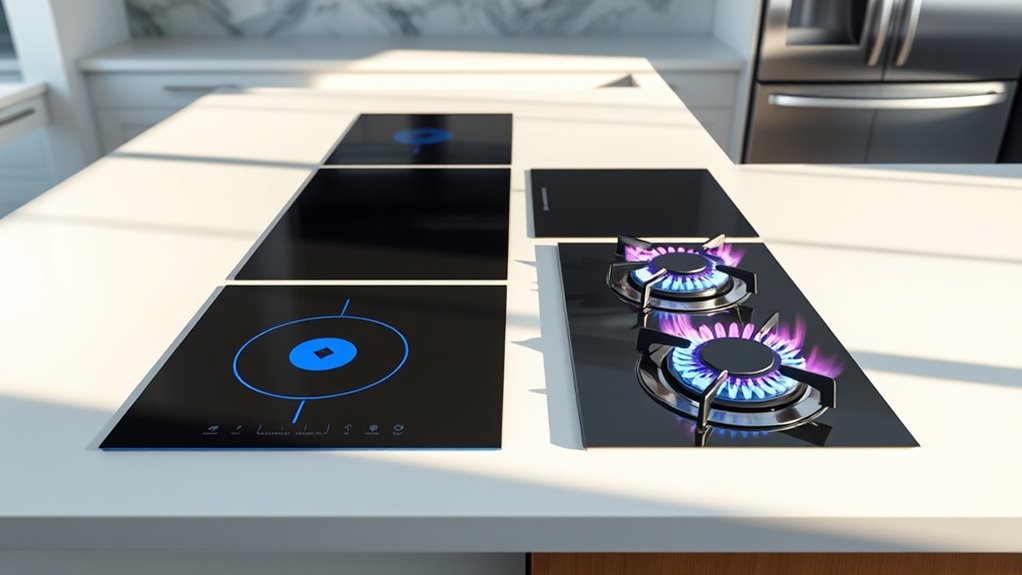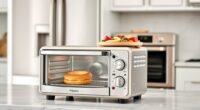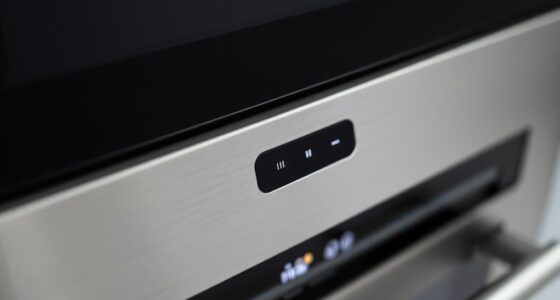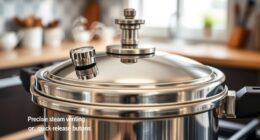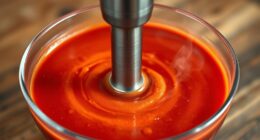Induction cooktops can be faster and safer than traditional gas or electric stoves because they heat cookware directly using electromagnetic fields, resulting in quick temperature changes and minimal surface heat. They’re also equipped with safety features like automatic shut-off and cool surfaces, making them a reliable choice. While some see them as a passing trend, ongoing advancements suggest induction is becoming a mainstay in modern kitchens. Discover the full story to see if it’s right for you.
Key Takeaways
- Induction cooktops heat cookware directly via electromagnetic fields, enabling faster heating compared to gas or electric stoves.
- They are safer due to cool surfaces, automatic shut-off, and lack of open flames, reducing fire risks and burns.
- The technology offers precise temperature control and energy efficiency, making cooking more responsive and environmentally friendly.
- While currently a small market share, rising consumer interest and technological advancements suggest long-term adoption over fads.
- Limitations like incompatible cookware and electromagnetic interference are manageable, but overall, induction is a practical, modern kitchen innovation.
What Is Induction Cooking?
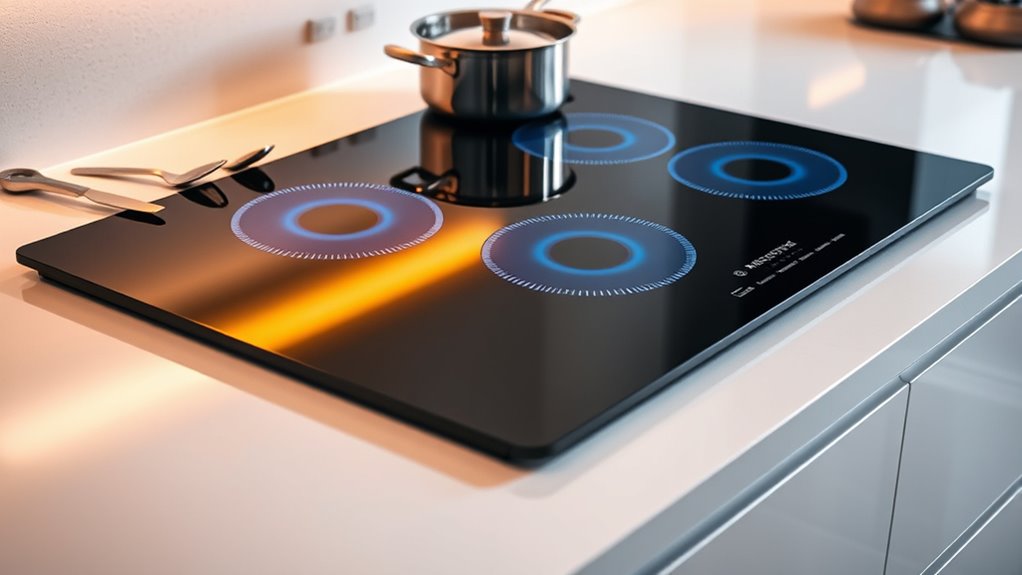
Have you ever wondered how induction cooking works? It uses electromagnetic fields beneath a smooth ceramic glass surface to directly heat magnetic cookware through magnetic induction. When you place compatible cookware—like cast iron or stainless steel—on the surface, the magnetic field causes rapid friction inside the pan, generating heat instantly. Unlike traditional stoves, induction cooktops don’t produce heat themselves; instead, they energize the cookware directly, offering rapid heating and precise temperature control. This technology improves safety because the cooktop stays cooler to the touch when not in use. Additionally, induction technology contributes to energy efficiency by heating only the cookware rather than the entire stovetop surface, which reduces wasted heat. Induction cooking also minimizes cooking accidents since the surface remains relatively cool, making it safer for busy kitchens. Moreover, the presence of a flat, smooth surface allows for easier cleanup and reduces the risk of spills and messes. The ceramic glass surface not only provides a sleek, easy-to-clean finish but also enhances the overall durability of the cooktop, making it a popular choice in modern kitchens. Plus, induction cooking is energy-efficient since it heats only the cookware, reducing wasted heat. Proper storage of cookware can help maintain optimal performance and safety during induction cooking.
How Do Induction Cooktops Work?
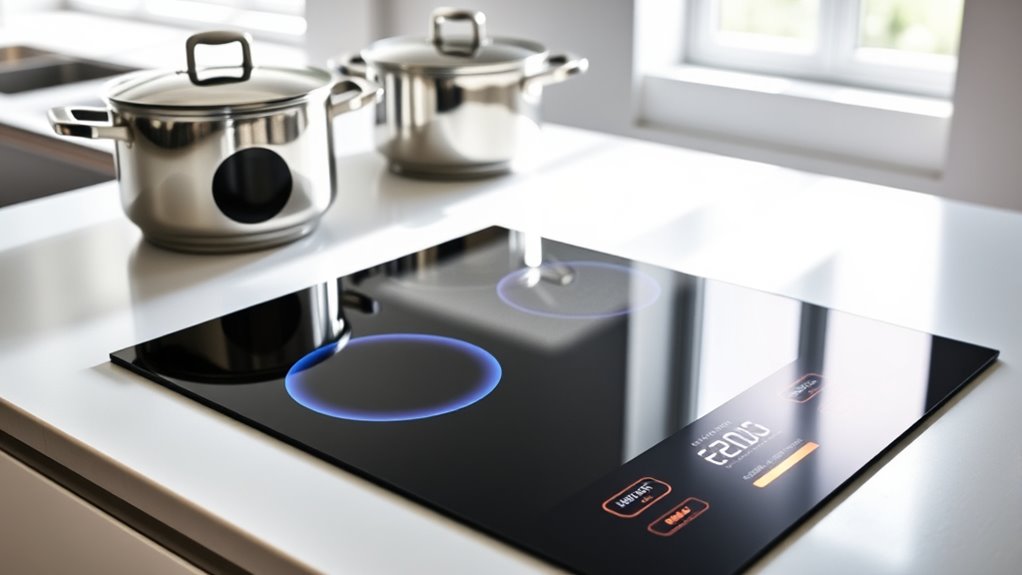
When you place compatible cookware on an induction cooktop, it creates a magnetic electromagnetic field beneath the surface. This field energizes the cookware directly, causing friction that heats it quickly and efficiently. Because heat is generated inside the cookware, the surface stays relatively cool, making the cooking process precise and safe. Additionally, diversify investments in the cookware or related appliances can help manage risks associated with new technology. Investing in unique and wicked planters or other innovative kitchen gadgets can also enhance your cooking experience and safety. Understanding emotional support can also be beneficial if users encounter challenges adapting to induction cooking. Incorporating professional voice actors in instructional videos or advertisements can further clarify the benefits and operation of induction cooktops for consumers.
Electromagnetic Field Generation
Induction cooktops generate a magnetic electromagnetic field beneath the glass surface by passing alternating current through copper coils. This creates a magnetic electromagnetic field that interacts with ferromagnetic cookware placed on the induction surface. When you set a compatible pot or pan, the electromagnetic energy induces Eddy currents within the metal. These currents generate heat due to electrical resistance, rapidly warming the cookware directly. The electromagnetic field only activates when ferromagnetic cookware is present, keeping the cooktop surface relatively cool and safe. The frequency of this magnetic electromagnetic field typically ranges from 20 to 100 kHz, optimized for efficient energy transfer and safety. This precise electromagnetic field generation is the core of how induction cooktops heat cookware quickly and efficiently.
Cookware Activation Process
How do induction cooktops activate their heating zones so quickly and efficiently? When you turn on an induction cooktop, it creates an electromagnetic field beneath the ceramic surface. This field interacts only with ferromagnetic cookware, thanks to their magnetic properties. When you place induction cookware on the surface, sensors detect its presence and trigger cookware activation. The electromagnetic field then induces electrical currents within the metal, causing heat generation directly inside the pan. This process ensures rapid heating and precise temperature control, as electronic adjustments fine-tune the electromagnetic field. Without ferromagnetic cookware, no heat is produced, and the cooktop stays cold. This efficient system allows induction cooktops to heat up swiftly and respond quickly to temperature changes, making them a standout in modern kitchens. Additionally, the energy efficiency of induction cooking reduces wasted heat, making it a popular choice for eco-conscious consumers. The safety features of induction cooktops, such as automatic shutdown when cookware is removed, also contribute to their growing popularity. The system’s ability to target specific cookware precisely minimizes heat loss and enhances overall cooking performance. Moreover, some models include smart technology that can be controlled remotely or integrated with home automation systems, further increasing their appeal. Furthermore, advanced ventilation and safety mechanisms help prevent overheating and ensure safe operation during prolonged use.
Direct Heat Transfer
The process of direct heat transfer in induction cooktops relies on creating a focused electromagnetic field beneath the glass surface that energizes ferromagnetic cookware directly. When you place compatible cookware with a magnetic base, the electromagnetic field causes electrons to oscillate, generating heat inside the pan through friction. Unlike electric or gas stoves, induction heats cookware instantly without warming the surface itself, enabling rapid temperature changes. This targeted heat transfer results in higher heat efficiency—about 85-90%—which conserves energy and reduces waste. Additionally, since the magnetic field concentrates only on active zones, safety improves, as the cooktop remains cool unless compatible cookware is present. The efficient energy transfer of induction technology supports its reputation as a faster, safer choice for modern kitchens. Advances in induction coil design continue to enhance performance and energy efficiency, further driving adoption. The market growth of induction technology reflects its increasing popularity among consumers seeking efficient and safe cooking options. As technology advances, the safety features of induction cooktops become even more reliable, making them a preferred choice for many households. Moreover, ongoing innovations in cooking technology aim to improve user experience and reliability.
Advantages of Induction Cooktops
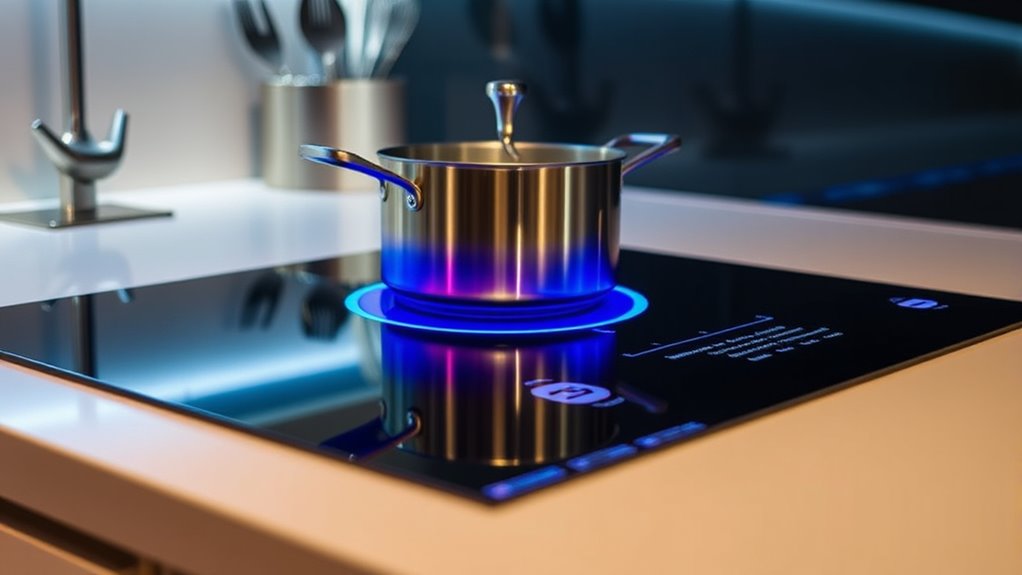
Induction cooktops heat up cookware quickly, saving you time and energy, while also offering precise control over temperature adjustments. The smooth glass surface stays cool and is easy to clean, making your cooking space safer and more convenient. Plus, their safety features and efficiency make them a smart choice for any household. Additionally, understanding Bitcoin IRA strategies can provide insights into maximizing financial safety and growth. Moreover, the safety features of induction cooktops can help prevent accidental burns and fires, enhancing overall kitchen safety. Because the self-regulating heating elements automatically adjust to maintain consistent temperatures, they further contribute to safer cooking environments. Furthermore, ongoing advancements in AI security help improve safety measures and protect users from vulnerabilities.
Rapid Heating and Cooling
Thanks to electromagnetic technology, induction cooktops heat cookware directly, allowing water to boil 2-4 minutes faster than gas or electric stoves. Induction heating offers a rapid heat response, so you can adjust temperature settings instantly, giving you precise control. Because heat is generated inside the cookware through electromagnetic fields, the surface stays relatively cool and cools quickly once you remove the pan, reducing residual heat. This rapid cooling not only enhances safety by minimizing burn risks but also prevents energy waste. The quick heating and cooling capabilities mean you spend less time waiting and more time cooking efficiently. Overall, induction’s rapid response and safety features make it a practical choice for modern kitchens.
Precise Temperature Control
Building on the rapid heating and cooling benefits, induction cooktops excel at providing precise temperature control. With the ability to adjust settings in just 1°F increments, you can fine-tune your cooking process for delicate tasks like simmering or melting. The electronic controls respond instantly, so your heat levels stay consistent even with small adjustments. Many models feature built-in temperature sensors that monitor cookware and automatically regulate power, preventing overheating. This precise temperature control minimizes energy waste by delivering only the heat you need, making your cooking more efficient. Plus, induction cooktops are compatible with a wide range of cookware, ensuring ideal performance. Overall, this accuracy enhances your cooking precision, helping you achieve perfect results every time.
Easy Cleaning and Safety
A smooth glass surface makes induction cooktops easy to clean, as spills and stains can be wiped away quickly with just a damp cloth. This glass cooktop surface resists stains and spills, simplifying maintenance and reducing mess. Safety is also enhanced because the surface stays relatively cool during cooking, lowering burn risks and preventing accidental fires. Many models feature automatic shut-off, activating when spills or overheating occur, which helps prevent accidents and protects your appliance. Unlike gas stoves, induction cooktops don’t produce open flames or hot surfaces, making them safer than gas for households with children or mobility challenges. Plus, the absence of residual heat after cooking minimizes burn risks, giving you peace of mind while cooking and cleaning.
Challenges and Limitations of Induction Cooking
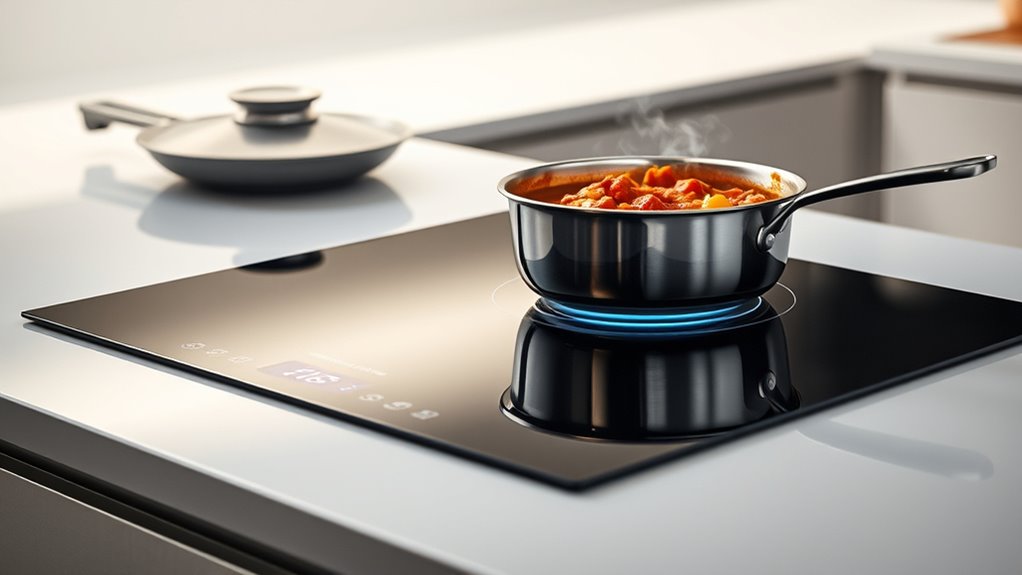
While induction cooktops offer rapid heating and precise control, they also come with notable challenges. You need compatible cookware made of ferromagnetic materials; aluminum or copper won’t work, limiting your options. During operation, you might notice buzzing, humming, or clicking sounds that can be distracting. Installation costs can be high, especially if you require electrical upgrades like a 240-volt outlet. Power outages make your cooktop unusable, unlike gas stoves that operate without electricity. Additionally, electromagnetic interference from magnetic fields can disrupt nearby electronic devices, including pacemakers and digital thermometers. Some users also report noise during operation, which can be bothersome. These limitations highlight that induction cooking isn’t without its hurdles, despite its advantages in speed and control.
Comparing Induction With Gas and Electric Options
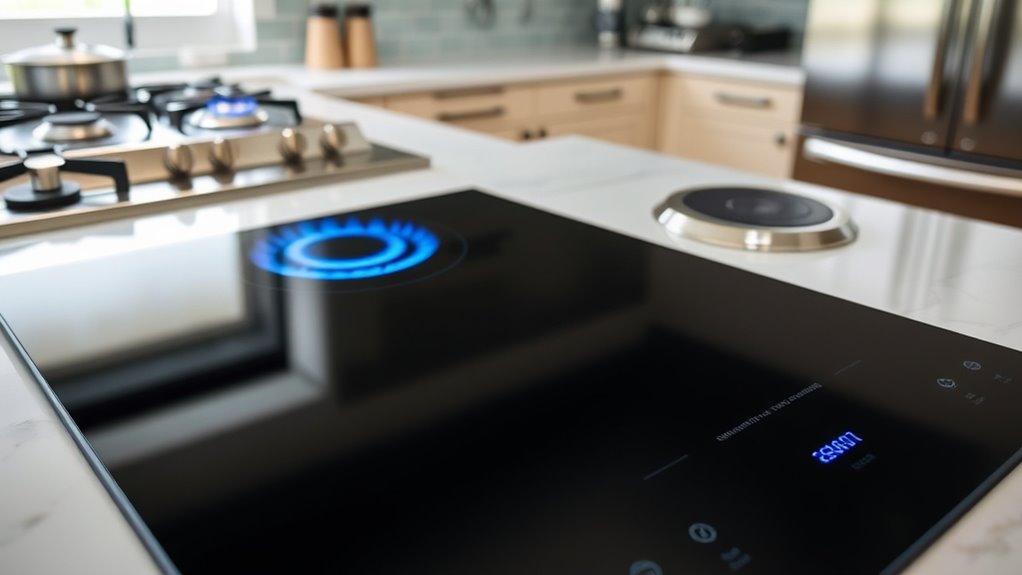
Induction cooktops stand out because they heat cookware directly through electromagnetic fields, making them about 2-3 times faster than traditional gas or electric stoves. When comparing induction with gas vs electric options, you’ll notice induction offers superior cooking speed and precise temperature control. Unlike gas stoves, induction models lack visible flames and feature safety features like automatic shut-off and cool surfaces, reducing burn risks. Compared to traditional electric cooktops, induction heats up faster and responds more quickly to adjustments, enhancing efficiency. However, induction requires compatible cookware with ferromagnetic properties, unlike standard electric appliances. While the initial cost may be higher, energy efficiency benefits translate into lower long-term operating costs. Overall, induction provides a faster, safer, and more responsive cooking experience than gas or electric options.
Which Cookware Is Compatible With Induction?
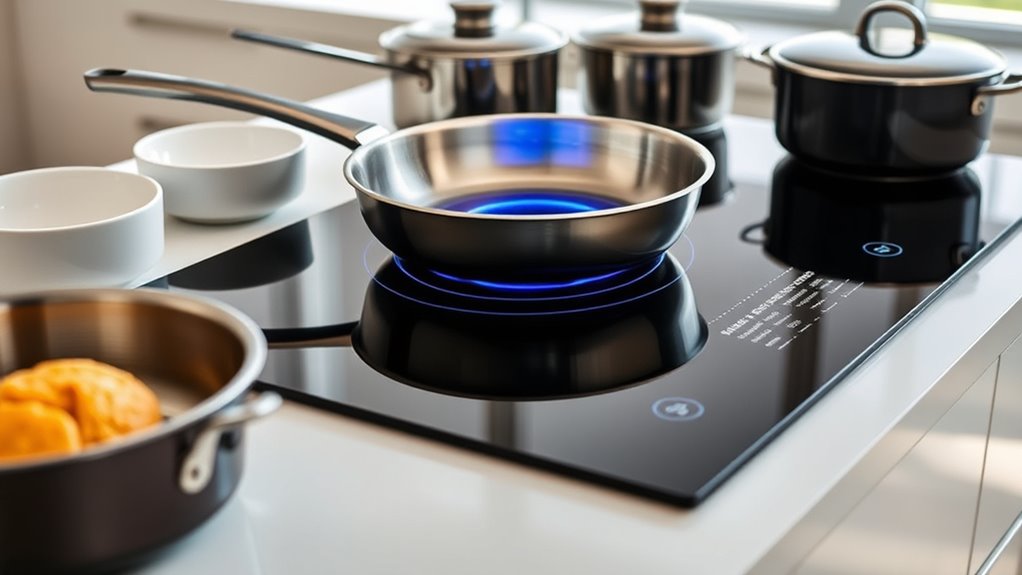
To cook efficiently on an induction cooktop, you need cookware that’s magnetic and compatible with electromagnetic fields. Conduct a magnet test: if a magnet sticks firmly to the bottom of your pan, it’s induction-compatible cookware. Ferromagnetic metals like cast iron and certain stainless steel types work best because they are attracted to magnets. Fully clad stainless steel with an iron core ensures better cookware compatibility, providing even heat distribution. However, non-magnetic metals like aluminum, copper, ceramic, and glass won’t work unless they have a magnetic base designed for induction cooking. Many manufacturers label their cookware as “induction-compatible,” making it easier to identify suitable options. Remember, the key is ensuring your cookware’s ferromagnetic properties to achieve efficient induction cooking.
Are Induction Cooktops Safe and Environmentally Friendly?
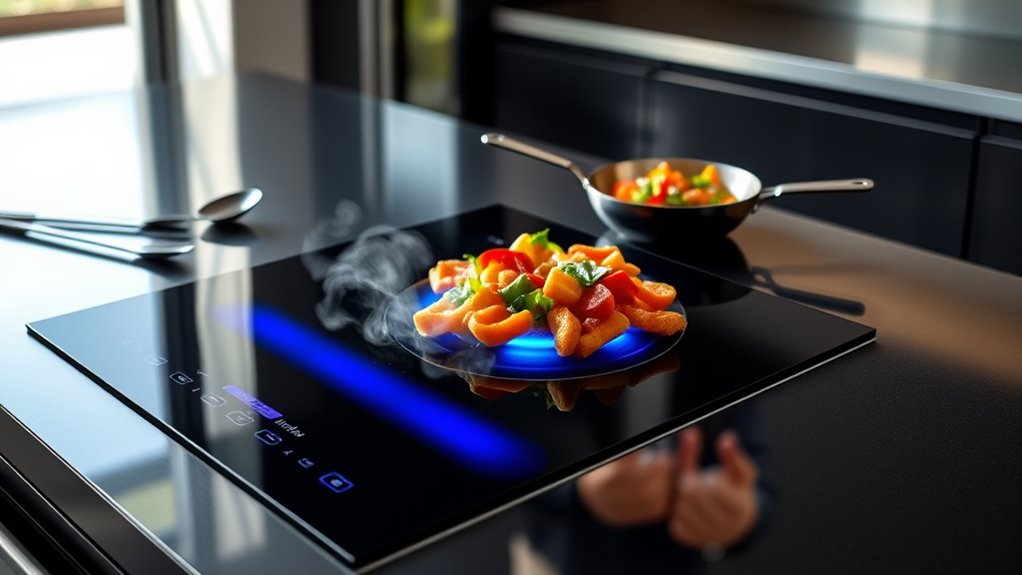
Are induction cooktops truly safe and environmentally friendly options for your kitchen? Induction safety is high because they heat only ferromagnetic cookware, keeping surfaces cool and reducing burn risks. Plus, they produce no direct emissions like methane or VOCs, which improves indoor air quality and supports eco-friendly cooking. Their energy efficiency reaches up to 85%, meaning less energy waste and a smaller carbon footprint. While electromagnetic fields are used, they generally pose minimal safety concerns and are shielded per safety standards, though those with pacemakers should consult their doctor. Overall, induction cooktops combine safety features with environmental benefits, making them a sustainable choice for modern kitchens seeking both safety and eco-consciousness.
Cost Considerations and Potential Rebates
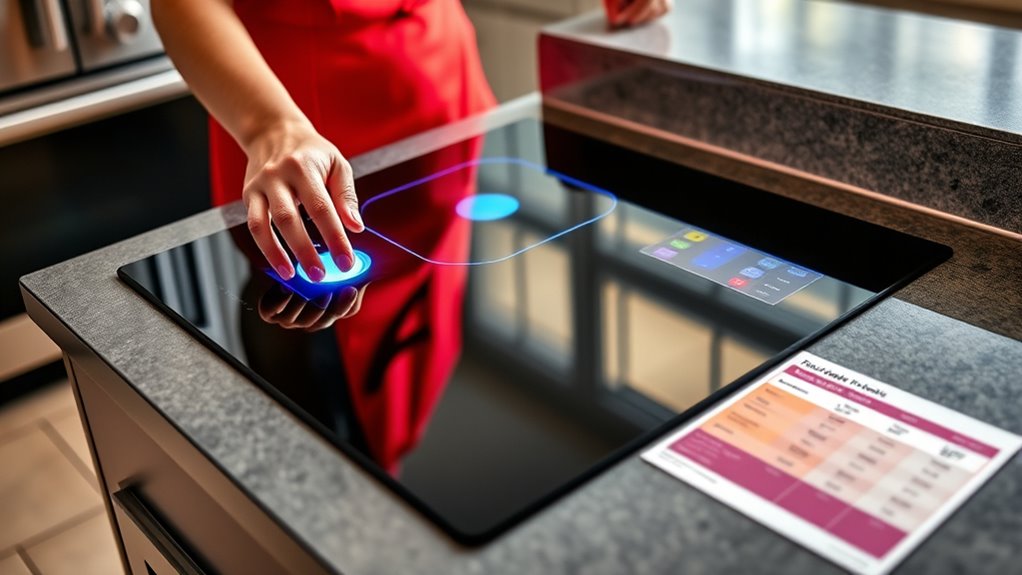
Upfront costs for induction cooktops tend to be higher than traditional electric or gas options, often ranging from $200 to over $1,000 more. Your initial purchase prices reflect this, but exploring rebates can help offset the expense. Many regions offer incentives for upgrading to ENERGY STAR® certified models, especially under programs like the Inflation Reduction Act, which may cover several hundred dollars. Keep in mind, installation costs can add to your total, as upgrading electrical systems from 120V to 240V and 50A circuits might be necessary. Researching costs beforehand ensures you understand the full expense. While induction cooktops may seem costly initially, rebates and decreasing model prices could make them a more attractive, affordable option in the long run, considering all the cost considerations involved.
Is Induction Cooking a Passing Trend or the Future?
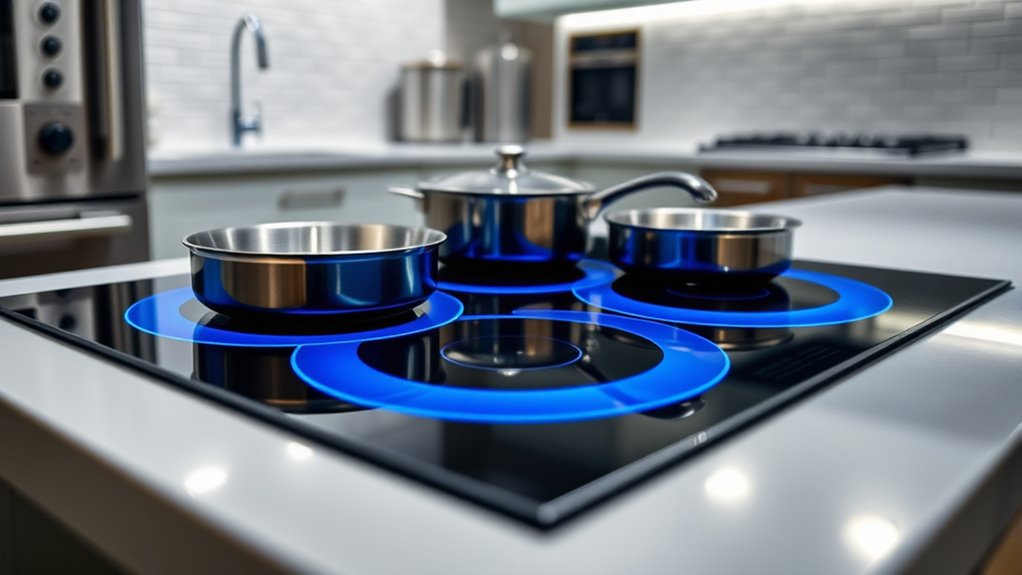
Induction cooking is rapidly gaining traction due to its efficiency, safety, and precision, suggesting it’s more than just a passing trend. With energy efficiency reaching up to 90%, it heats cookware 2-3 times faster than gas or electric stoves. Though induction still accounts for less than 5% of sales, its growing endorsement by appliance innovation leaders and professional chefs signals a shift toward wider induction adoption. As costs decrease and compatible cookware becomes more accessible, induction is poised to become a staple in the future kitchen. Governments promoting environmental benefits through rebates further boost its appeal. This combination of technological advancements and consumer interest indicates that induction cooking is shaping the future of cooking technology, making it more than just a fleeting craze.
Frequently Asked Questions
What Is the Downside of an Induction Cooktop?
The downside of an induction cooktop is that it demands compatible ferromagnetic cookware, which means you might need to buy new pots and pans. You could also experience distracting buzzing or humming noises at high settings. Plus, the electromagnetic fields might interfere with your electronic devices or health conditions. Additionally, induction stoves tend to cost more upfront and may require professional installation, making them less convenient for some users.
What Is the Disadvantage of Induction?
You might think induction is the future of cooking, but beware of its downsides. You’ll need compatible cookware, or your stove won’t work. The upfront costs can surprise you, and noisy operation might distract you. Plus, you’ll be vulnerable during power outages, and magnetic fields could interfere with medical devices. These hidden challenges make induction less perfect than it seems, so weigh the risks before jumping in.
What Is the Common Problem in an Induction Stove?
A common problem with induction stoves is that they don’t work with non-magnetic cookware, so you might find your pots and pans useless if they’re not compatible. You may also notice buzzing or humming sounds during operation, especially at high settings. Residue buildup on the glass surface can cause uneven cooking, and electrical issues like overloads can make the stove shut off unexpectedly. Additionally, magnetic fields can interfere with nearby electronic devices.
Are Induction Cooktops Safer?
You might wonder if induction cooktops are safer, and the answer is yes. Picture a sleek surface that stays cool to the touch, reducing burn risks, while the heat focuses only on your cookware. They turn off automatically if something’s wrong, preventing fires or overheating. With no open flames and minimal electromagnetic exposure, you feel more secure cooking, especially around children or seniors. Induction cooktops prioritize safety without sacrificing convenience.
Why Don’t Chefs Use Induction?
You might wonder why chefs don’t fully embrace induction cooktops. They often prefer gas because of its visual flame, which offers better control and feedback. Many chefs also rely on traditional cookware, which induction requires specifically ferromagnetic pans, adding costs. Plus, induction’s electronic controls and noise can be disruptive in a busy kitchen. So, despite its advantages, these factors make induction less attractive for professional chefs.
Conclusion
Induction cooktops are fast, safe, and eco-friendly options for your kitchen. They heat quickly, save energy, and keep your countertops cool, making cooking safer and more efficient. While they require compatible cookware and come with a higher upfront cost, their benefits often outweigh these challenges. Whether you see them as a passing trend or the future of cooking, one thing’s clear: induction offers a smarter, sleeker way to cook, making your kitchen more modern, more convenient, more enjoyable.
